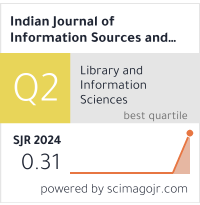Yoga Research Output in India: A Scientometric Study
DOI:
https://doi.org/10.51983/ijiss.2019.9.2.617Keywords:
Scientometrics, Yoga, Web of ScienceAbstract
This article presents the research output of Yoga in India using different Scientometric approach both quantitative and qualitative methods. Bibliographic data for the study has been collected from the Web of Science Core Collection online database of Thomson Scientific, USA. The strings ‘Yoga and India’ in the topic and address field are used for retrieving data. Researcher have published 525 publications with 6683 Global Citations Scores (H-Index: 45) were selected and 525 publications which were used for further data analysis. Prominent Authors were identified by name, subject domain and able to place their papers in high impact journals. Moreover it has identified Countries wise collaboration of the research. 8 papers are received more than 100 citations. India has collaborated with 32 countries.
References
Amarjeet, Y., & Sohan, R. T. (2011). Yoga spectrum. Delhi: Avinash Paperbacks.
Barnes, P.-M., Bloom, B., & Nahin, R. (2008). CDC National Health Statistics Report #12: Complementary and alternative medicine use among adults and children. Retrieved from: nccam.nih.gov/news/camstats. Accessed on 25th March 2013.
Blom, K., Baker, B., How, M., Dai, M., Abbey, S., & Myers, M. (2012). Hypertension analysis of stress reduction using mindfulness meditation and yoga: Results from a randomized controlled trial. Can J Cardiol, 28(5), 418-419.
Caroline, S., Heather, H., Jane, B., & Kerena, E. (2007). A randomised comparative trial of yoga and relaxation to reduce stress and anxiety, Complementary Therapies in Medicine, 15(2), 77-83. Retrieved from: https://doi.org/10.1016/j.ctim.2006.05.001.
Catherine, W. (2011). Exploring the therapeutic effects of yoga and its ability to increase quality of life. International Journal of Yoga, 4(2), 49–54.
Cramer, H., Lauche, R., & Dobos, G. (2014). Characteristics of randomized controlled trials of yoga: a bibliometric analysis. BMC Complementary and Alternative Medicine, 14, 328. Retrieved from: https://doi.org /10.1186/1472-6882-14-328.
Dunn A.-L., Trivedi M.-H., & O’Neal H.-A. (Jun, 2001) Physical activity dose-response effects on outcomes of depression and anxiety. Med Sci Sports Exerc, 33(6), 587–610. [PubMed].
Engin, S. (2019). Evolution of homeopathy: A scientometric analysis of global homeopathy literature between 1975 and 2017. Complementary Therapies in Clinical Practice, 34, 165–173.
Fox, K. (1999). The influence of physical activity on mental well-being. Public Health Nutr, 2, 411–18.
Gupta, B.-M., Ahmed, K.-K.-M., Dhawan, S.M., & Gupta, R. (2018). Yoga Research a Scientometric Assessment of Global Publications Output during 2007-16. Pharmacog Journal, 10(3), 394-402.
Imran Khan, (2016). A scientometric analysis of DESIDOC Journal of Library & Information Technology (2010-2014). Library Hi Tech News, 33(7), 8-12. Retrieved from: https://doi.org/10.1108/LHTN-03-2016-0014.
Jeter, P.-E., Slutsky, J., Singh, N., & Khalsa, S.-B. (2015). Yoga as a Therapeutic Intervention: A Bibliometric Analysis of Published Research Studies from 1967 to 2013. The Journal of Alternative and Complementary Medicine, 21(10), 586-92.
Khalsa, S.-B. (2004). Yoga as a therapeutic intervention: A bibliometric analysis of published research studies. Indian Journal Physiology and Pharmacology, 48(3), 269-285.
Kirkwood, G., Rampes, H., Tuffrey, V., Richardson, J., & Pilkington, K. (2005). Yoga for anxiety: a systematic review of the research evidence. British Journal of Sports Medicine, 39(12), 884-891. Retrieved from: http://dx.doi.org/10.1136/bjsm.2005.018069.
Pailoor, S., & Shirley.T. (2009) A review of the scientific studies on cyclic meditation. International Journal of Yoga, 2(2), 46–48. Retrieved from: https://doi.org/10.4103/0973-6131.60043.
Pamela, E.-J., Jeremiah, S., Nilkamal, S., & Sat Bir S.-K. (2015). Yoga as a Therapeutic Intervention: A Bibliometric Analysis of Published Research Studies from 1967 to 2013. The Journal of Alternative and Complementary Medicine, 21(10). Retrieved from: https://doi.org/10.1089/acm.2015.0057.
Pilkington, K., Kirkwood, G., Rampes, H. & Richardson, J. (2005). Yoga for depression: the research evidence. Journal of Affective Disorders, 89(1-3), 13-24.
Pilkington, K., & CAM-Cancer Consortium. (2013). Yoga. CAM-Cancer Database National Information Center for Complementary and Alternative Medicine (NIFAB).
Salmon, P. (2001). Effects of physical exercise on anxiety, depression, and sensitivity to stress: a unifying theory. Clinical Psychology, 21(1), 33–61. [PubMed].
Pritchard, A. (1969). Statistical bibliography or bibliometrics. Journal of Documentation, 25(4), 348-349.
Naveed S, Waqas A, Majeed S et al., (2017). Child psychiatry: A scientometric analysis 1980-2016. F1000 Research, 6-1293. Retrieved from: https://doi.org/10.12688/f1000research.12069.1
Sharma, M. (2013). Yoga as an Alternative and Complementary Approach for Stress Management: A Systematic Review. Journal of Evidence-Based Integrative Medicine. Retrieved from: https://doi.org/10.1177/2156587213503344.
Sharma, M. (2012). Yoga as an Alternative and Complementary Therapy for Patients Suffering From Anxiety: A Systematic Review. Journal of Evidence-Based Integrative Medicine. Retrieved from: https://doi. org/10.1177/2156587212460046.
Vethathiri Maharishi. (2007). Yoga for Modern Age (10th ed.). Vethathiri Publications.
Downloads
Published
How to Cite
Issue
Section
License
Copyright (c) 2019 The Research Publication

This work is licensed under a Creative Commons Attribution-NonCommercial-NoDerivatives 4.0 International License.









